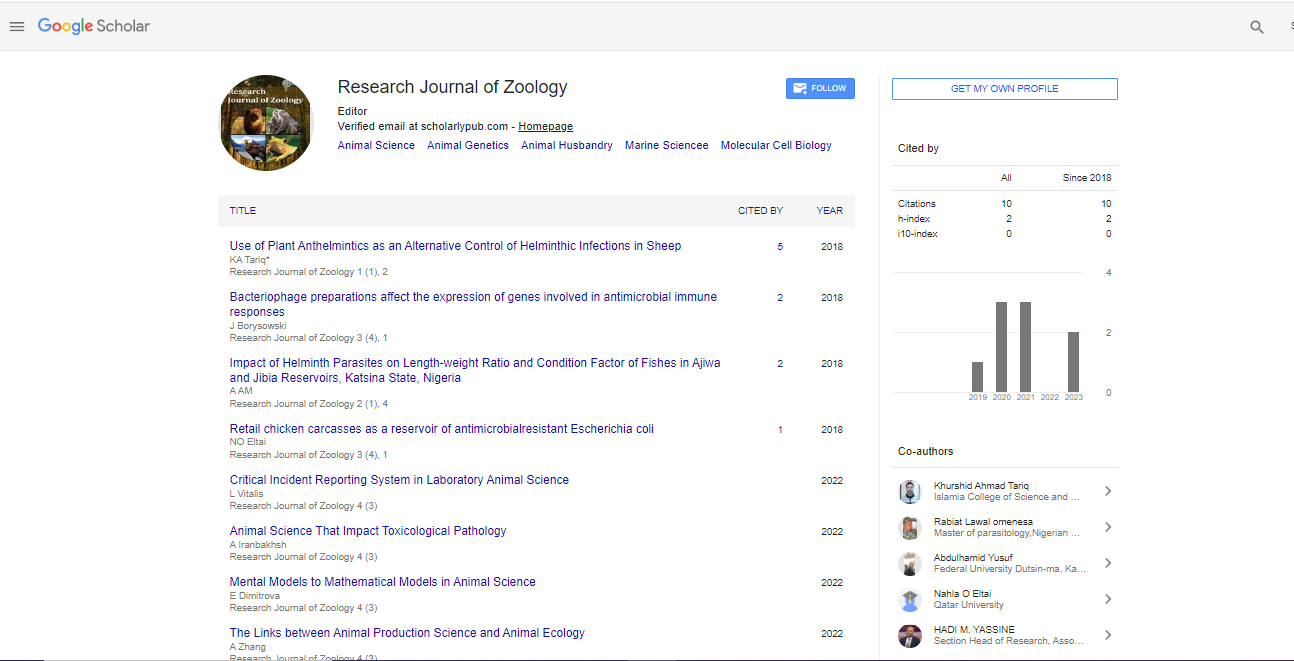Perspective, Res J Zool Vol: 5 Issue: 2
The Importance of Vertebrate Zoology in Conservation of Biodiversity
Julie Stafford*
1 Department of Zoology, University of Cambridge, Cambridge, United Kingdom
*Corresponding Author: Julie Stafford,
Department of Zoology, University
of Cambridge, Cambridge, United Kingdom
E-mail: staffordjulie@gmail.com
Received date: 29 May, 2023, Manuscript No. RJZ-23-106876;
Editor assigned date: 31 May, 2023, PreQC No. RJZ-23-106876 (PQ);
Reviewed date: 14 June, 2023, QC No. RJZ-23-106876;
Revised date: 21 June, 2023, Manuscript No. RJZ-23-106876 (R);
Published date: 28 June, 2023, DOI: 10.4172/Rjz.1000081.
Citation: Stafford J (2023) The Importance of Vertebrate Zoology in Conservation of Biodiversity. Res J Zool 5:2.
Description
Vertebrate zoology is the branch of zoology that focuses on the study of vertebrate animals, which are organisms with a backbone or spinal column. Vertebrates comprise a diverse group of animals that include mammals, birds, reptiles, amphibians, and fish. This field of study examines the anatomy, physiology, behavior, ecology, evolution, and conservation of vertebrates. Vertebrate zoologists play a difficult role in understanding the complexity of these animals and their interactions with the environment.
Taxonomy and diversity of vertebrates
Vertebrate zoology involves the classification and study of the immense diversity of vertebrate animals. Vertebrates are organized into five major classes.
Mammals: Mammals are warm-blooded vertebrates that have hair or fur, mammary glands, and a four-chambered heart. They include diverse creatures from tiny bats to massive whales.
Birds: Birds are warm-blooded vertebrates characterized by feathers, beaks, and the ability to fly. They exhibit remarkable adaptations for flight and have diverse ecological roles.
Reptiles: Reptiles are cold-blooded vertebrates with scales and lay amniotic eggs. They include snakes, lizards, turtles, and crocodiles.
Amphibians: Amphibians are cold-blooded vertebrates that typically undergo metamorphosis during their life cycle. They include frogs, toads, newts, and salamanders.
Fish: Fish are cold-blooded vertebrates that live primarily in aquatic environments. They are diverse, with species ranging from jawless fish like lampreys to bony fish and cartilaginous fish like sharks and rays.
Anatomy and physiology of vertebrates
The study of vertebrate anatomy and physiology involves examining the structure and function of various body systems. This includes the nervous system, respiratory system, circulatory system, digestive system, and reproductive system. Understanding vertebrate physiology is essential for comprehending how animals adapt to their environments and meet the demands of survival and reproduction.
Behavior and ecology of vertebrates
Vertebrate zoologists study the behavior and ecology of vertebrate animals to understand their interactions with the environment and other organisms. This includes aspects such as mating behaviors, parental care, migration, foraging strategies, and social structures. The study of vertebrate ecology also involves investigating the relationships between vertebrates and their habitats, as well as their roles in food webs and ecosystems.
Evolutionary history and paleontology
The field of vertebrate zoology delves into the evolutionary history of vertebrates, including the study of fossils and paleontology. Fossils provide important insights into the origins and diversification of vertebrate groups and help reconstruct the evolutionary processes that shaped modern vertebrate diversity.
Conservation and biodiversity
Vertebrate zoologists play a crucial role in conservation efforts to protect vertebrate species and their habitats. They study endangered species, assess population dynamics, and work to develop strategies for sustainable management of wildlife populations. By understanding the ecological needs and threats facing vertebrates, conservationists can design effective conservation plans to safeguard biodiversity.
Conclusion
In conclusion, vertebrate zoology is a multifaceted field that explores the biology, diversity, and ecology of vertebrate animals. Vertebrate zoology is of paramount importance for advancing our understanding of the diversity, adaptations, and ecological roles of vertebrate animals. It provides essential knowledge for conservation efforts, wildlife management, and sustainable use of natural resources. Moreover, vertebrate zoology contributes to broader fields such as evolutionary biology, ecology, and environmental science, enriching our comprehension of the natural world and our place within it. From the smallest hummingbird to the largest whale, vertebrates exhibit remarkable adaptations that have allowed them to thrive in various habitats across the globe. The study of vertebrate zoology is essential for our understanding of these incredible creatures and their vital roles in shaping ecosystems and maintaining biodiversity. As we continue to explore and protect the natural world, vertebrate zoology remains a cornerstone of scientific inquiry and conservation efforts.
 Spanish
Spanish  Chinese
Chinese  Russian
Russian  German
German  French
French  Japanese
Japanese  Portuguese
Portuguese  Hindi
Hindi 
